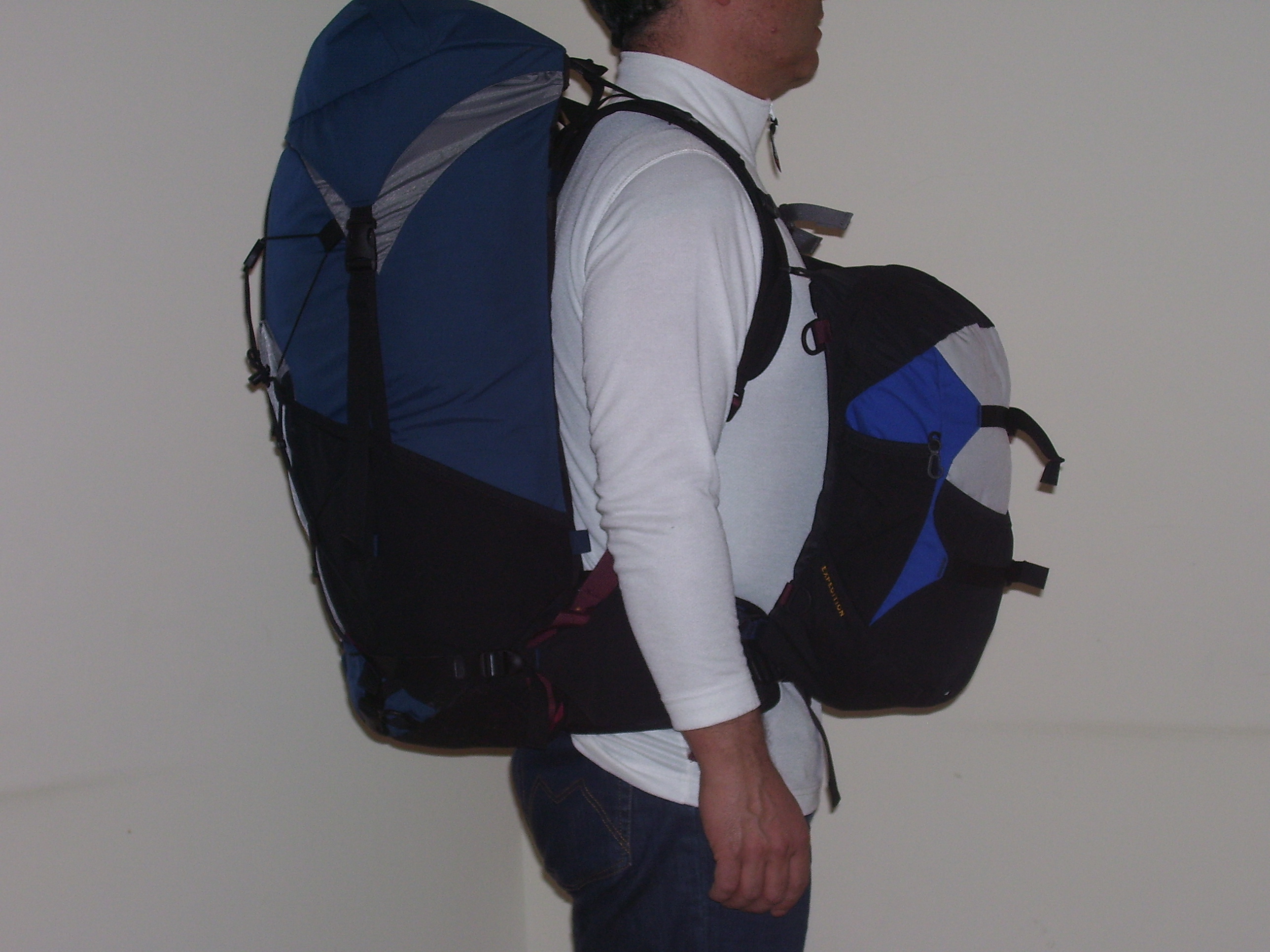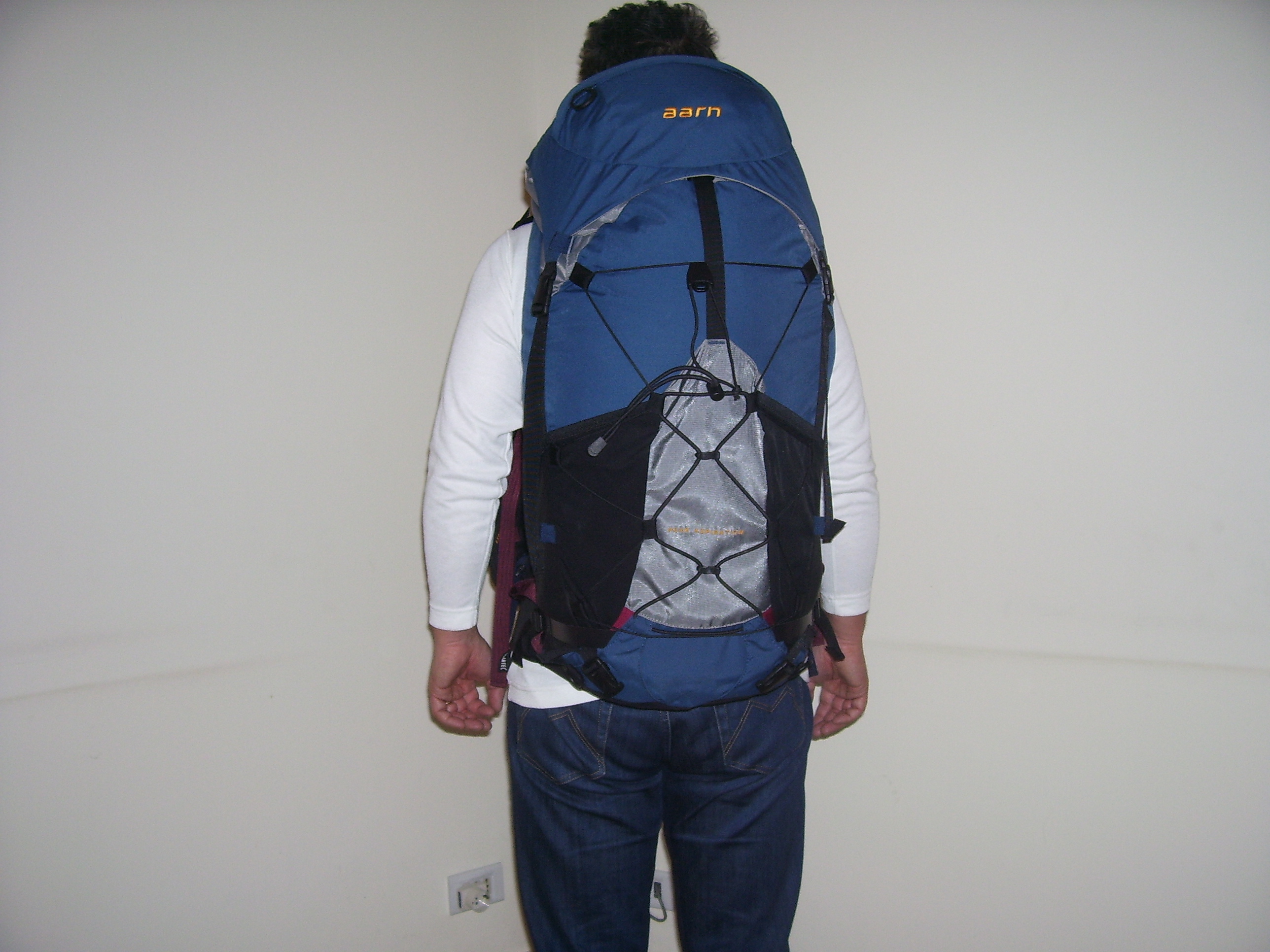Introduction to Aarn bodypacks
What should a pack do? A pack for multi-days hikes must:
contain everything you need during the trek
being as light as possible
without restraining movements
and reducing stress and probability of assorted injuries to the absolute possible minimum
The first two problems are relatively easy to solve:
the majority of backpacks on the market, including most cheap models, does it in a generally satisfying way and the same could be said, at least partially, when it comes to not restraining movements. The most important point, however, is the last one. Besides being possible only if you have already minimized bulk and weight of what goes inside the pack, making a pack light and small does little if carrying it requires more energies and stresses your body more than it is absolutely necessary.
Aarn Tate and Devi Bension, down in New Zealand, make packs different from almost all others, with very interesting features from the comfort and ergonomics points of view. After years of thinking about it, I’ve finally had the possibility to test the 2008 versions of the Peak Aspiration pack (a model designed for mountaineering and multi-day backpacking) and of the Expedition front pockets. This article is a short introduction to the unique features of Aarn Design products and their makers. Later on, I’ll describe in detail the pack, the pockets, their actual effectiveness in the the field and the best way to use them.
Environmental and social impact
As already mentioned in the introduction to the website, Strider will pay constant attention to these themes: if we love wilderness so much to spend whole days in it, we should protect it before even leaving home, that is choose gear which last as long as possible, is recyclable and is produced with the least possible amount of energy and raw materials. As far as Aarn Design is concerned, their medium/long term goal is to “replace non biodegradable materials with biodegradable ones as they become available”. In the meantime, the company already uses renewable energy and takes care of recycling: when you don’t need your pack anymore, send it back to them and they’ll recover everything that can be recycled or reused. This isn’t likely the greener solution for customers not living in Australia or New Zealand, since even overseas shipping pollutes. In any case, it is great to see small makers of backpacking gear to be so active in protecting the environment, and theirs is an example that everybody should follow. I intend to ask Aarn practical advice, which I’ll publish here, about the best way to recycle their products when shipping them back is not an option.
When it comes to manufacturing, Aarn must make ends meet as anybody else so they, too have moved production to China: according to the website, however, their is “a modern new factory with good working conditions. You can be sure that your pack is not made in a sweatshop!”
Bodypacks and the Flowmo system
Aarn packs are not normal packs. Normal packs are carried on your back: this is why they are called backpacks. Sure, belts, frames of all sorts, sophisticated shoulder straps and pack shapes do much to reduce the effort to carry any given weigth, but the basic fact doesn’t change. Aarn packs, instead, could be used in the traditional way, but they are meant to be used as bodypacks, that is as integrated pack-and-pockets systems to be carried around your body. The bottoms of the shoulder straps are connected by one single sling which slides, to facilitate the natural movement of your shoulders even while skiing or climbing. According to Aarn, the single continuous sling also distributes the load more evenly across the straps and the pack frame, making them last longer.


Even more important are the front balance pockets. As you can see in the picture, they allow to distribute weight in such a way that it becomes possible to walk without leaning forward as one would be forced to do by normal backpacks. This is already something good, as it reduces, at least with heavy loads, the effort required to carry them, but isn’t the best part.
The most important advantage of this way to carry weights is that it causes much less problems to your back, just because the center of gravity remains the same of when you walk without the pack: besides not causing pains or aggravating existing back problems, this way of carrying a pack may even allow you to backpack more years. Personally, this is the main reason why, when I discovered Aarn packs a while ago, I thought “sooner or later, I must really discover if this is true”.
This possibility to spread the load around the body is the most important thing. An Aarn pack doesn’t make much sense if bought and used without front pockets, and the bigger (and heavier) these are the better it is for your back. This, of course, doesn’t prevent you from using without the pockets, when it’s time to climb, one of the Aarn packs designed for mountaineering.


In the next article of this series I’ll describe in detail the 2008 edition of the 40⁄45 liters Peak Aspiration pack, which you can see in the picture and is different from the one still shown (as of March 2008) on the Aarn website.
Following that, I’ll publish a review of the Expedition balance pockets (16 liters per pair) and a report on how this particular bodypack, that is this specific pack+pockets combination works in the field. In the meantime, I’ll just anticipate that this is very interesting gear which does work as advertised, even if they have to be used in the right way.
If you have any question for me or Aarn, or if you want some specific points, or parts of the packs and pockets, covered in great detail (with both text and pictures!) in the next articles, please let me know in the comments.
_(Thanks to Fabrizio for helping with the pictures!) _
